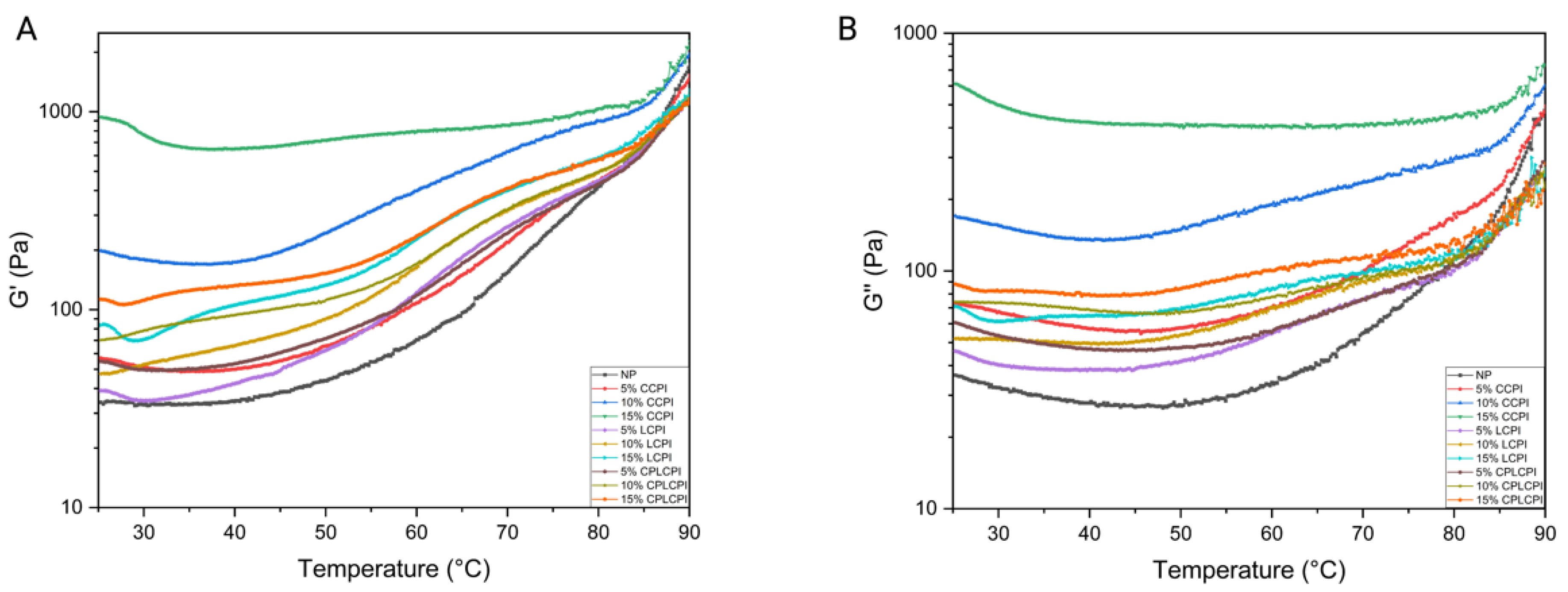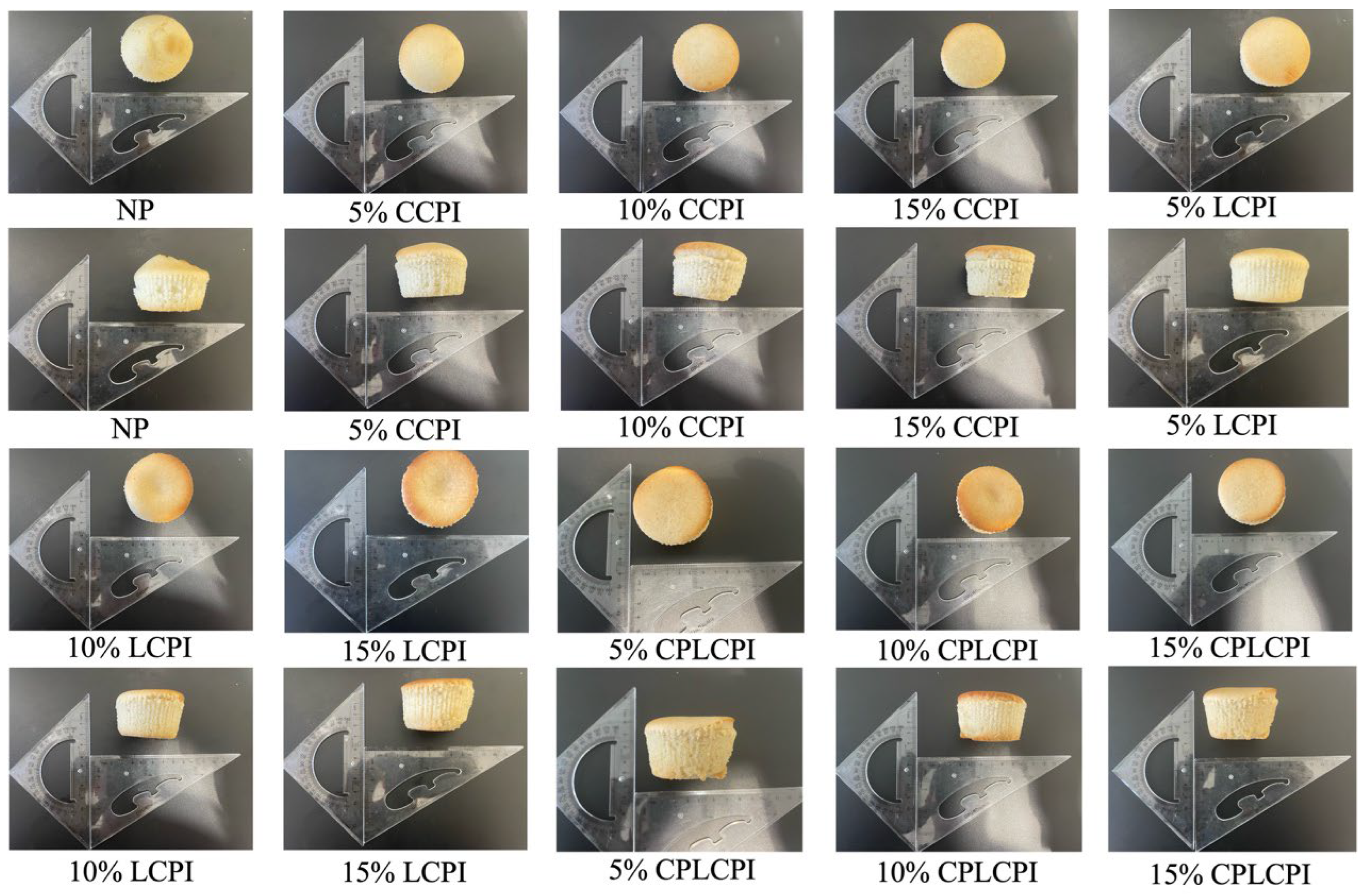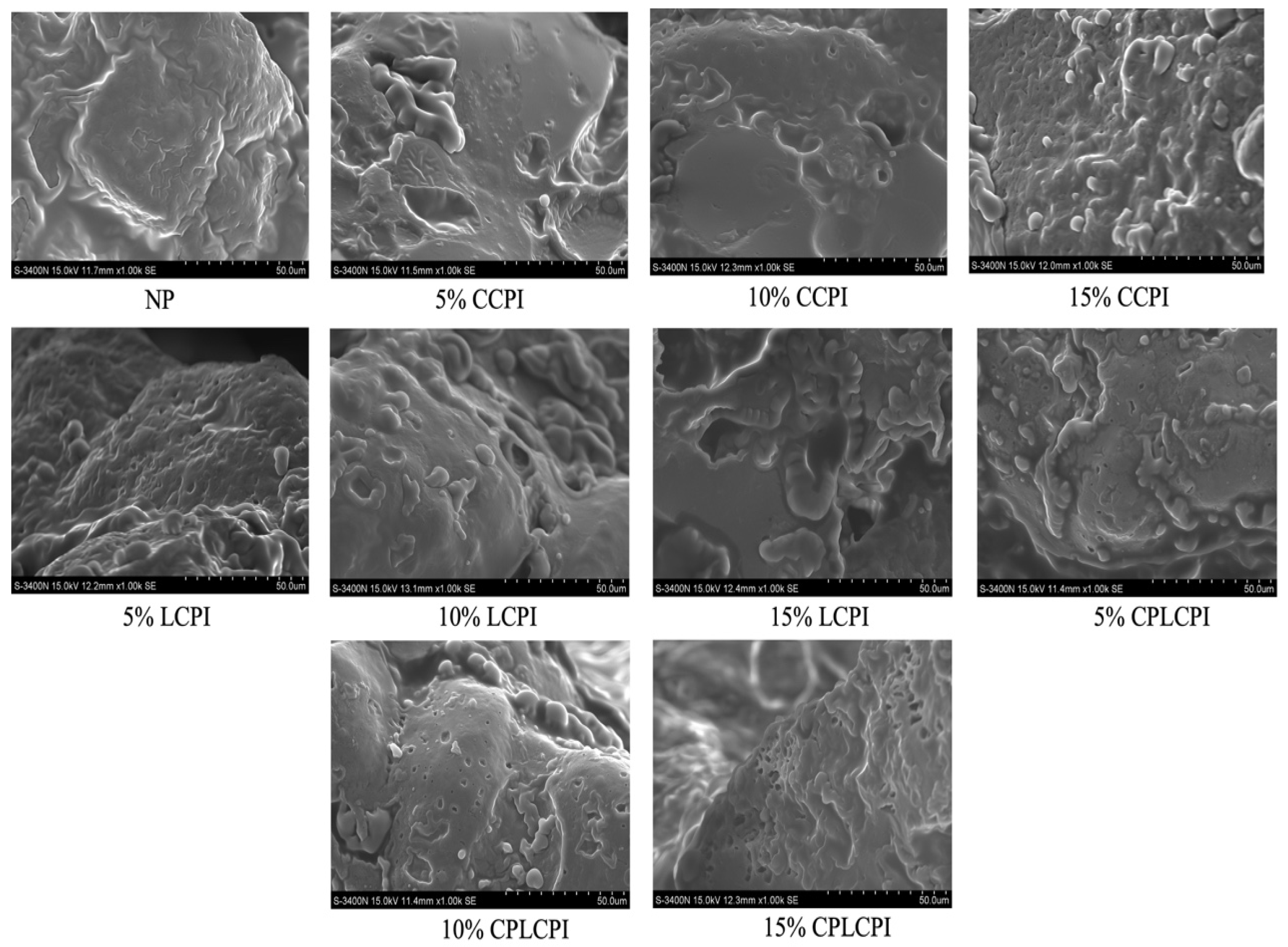Cold Plasma-Treated Chickpea Protein Isolate: Effects on Rheological Behavior and Quality Characteristics of Allergen-Free Rice Muffins
Abstract
1. Introduction
2. Materials and Methods
2.1. Materials
2.2. AF Muffin Batter Preparation
2.3. Rheological Properties of AF Muffin Batters
2.4. AF Muffin Preparation
2.5. AF Muffin Properties
2.6. Micro-Structure of AF Muffin
2.7. Statistical Analysis
3. Results
3.1. Rheological Properties of Batters
3.1.1. Apparent Viscosity
3.1.2. Frequency Sweep
3.1.3. Temperature Sweep
3.2. Height, Volume and Baking Losses of AF Muffins
3.3. Color Parameters of AF Muffins
3.4. Textural Properties of AF Muffins
3.5. Micro-Structure of AF Muffins
4. Conclusions
Author Contributions
Funding
Institutional Review Board Statement
Informed Consent Statement
Data Availability Statement
Conflicts of Interest
Abbreviations
| AF | Allergen-free |
| CPI | Chickpea protein isolate |
| FA | Food allergies |
| CP | Cold plasma |
| CMC | Carboxymethyl cellulose sodium |
| LVR | Linear viscoelastic region |
References
- Food and Agriculture Organization of the United Nations. 2025. Available online: https://www.fao.org/food-safety/scientific-advice/food-allergens/en/ (accessed on 21 January 2025).
- Bartha, I.; Almulhem, N.; Santos, A.F. Feast for thought: A comprehensive review of food allergy 2021–2023. J. Allergy Clin. Immunol. 2024, 153, 576–594. [Google Scholar] [CrossRef]
- Wong, G.W.-K. Food allergies around the world. Front. Nutr. 2024, 11, 1373110. [Google Scholar] [CrossRef]
- Sampath, V.; Abrams, E.M.; Adlou, B.; Akdis, C.; Akdis, M.; Brough, H.A.; Chan, S.; Chatchatee, P.; Chinthrajah, R.S.; Cocco, R.R.; et al. Food allergy across the globe. J. Allergy Clin. Immunol. 2021, 148, 1347–1364. [Google Scholar] [CrossRef] [PubMed]
- Tedner, S.G.; Asarnoj, A.; Thulin, H.; Westman, M.; Konradsen, J.R.; Nilsson, C. Food allergy and hypersensitivity reactions in children and adults—A review. J. Intern. Med. 2022, 291, 283–302. [Google Scholar] [CrossRef]
- FAO; WHO. Risk Assessment of Food Allergens. Part 1: Review and Validation of Codex Alimentarius Priority Allergen List Through Risk Assessment; Food Safety and Quality Series No. 14; FAO: Rome, Italy; WHO: Geneva, Switzerland, 2022. [CrossRef]
- Ghorbani, A.; Rafe, A.; Hesarinejad, M.A.; Lorenzo, J.M. Impact of pH on the Physicochemical, Structural, and Techno—Functional Properties of Sesame Protein Isolate. Food Sci. Nutr. 2025, 13, e4760. [Google Scholar] [CrossRef] [PubMed]
- O’Shea, N.; Arendt, E.; Gallagher, E. State of the Art in Gluten-Free Research. J. Food Sci. 2014, 79, R1067–R1076. [Google Scholar] [CrossRef] [PubMed]
- Xu, J.; Zhang, Y.; Wang, W.; Li, Y. Advanced properties of gluten-free cookies, cakes, and crackers: A review. Trends Food Sci. Technol. 2020, 103, 200–213. [Google Scholar] [CrossRef]
- Yazici, G.N.; Ozer, M.S. A review of egg replacement in cake production: Effects on batter and cake properties. Trends Food Sci. Technol. 2021, 111, 346–359. [Google Scholar] [CrossRef]
- Jeong, D.; Chung, H.-J. Physical, textural and sensory characteristics of legume-based gluten-free muffin enriched with waxy rice flour. Food Sci. Biotechnol. 2019, 28, 87–97. [Google Scholar] [CrossRef]
- Arora, K.; Tlais, A.; Augustin, G.; Grano, D.; Filannino, P.; Gobbetti, M.; Di Cagno, R. Physicochemical, nutritional, and functional characterization of gluten-free ingredients and their impact on the bread texture. LWT 2023, 117, 114566. [Google Scholar] [CrossRef]
- Yang, Y.; Zhang, C.; Ma, C.; Hu, L.; Bian, X.; Wang, B.; Zhang, N. Impact of soybean protein isolate on gluten-free bread: A comprehensive study of physicochemical properties of gluten-free dough and bread matrix properties. Int. J. Food Sci. Technol. 2024, 59, 251–264. [Google Scholar] [CrossRef]
- Zhang, Y.; Zhou, J.; Tian, W.; Gui, Y.; Li, Y. Effects of soy flour formulation and pretreatment on the properties of gluten-free cookies: A comprehensive study from flour, dough, to baked products. Food Chem. 2025, 468, 142481. [Google Scholar] [CrossRef] [PubMed]
- Badiu, E.; Aprodu, I.; Banu, I. Trends in the development of gluten-free bakery products. The Annals of the University Dunarea de Jos of Galati. Fascicle VI—Food Technol. 2014, 38, 1. [Google Scholar]
- Stantiall, S.E.; Serventi, L. Nutritional and sensory challenges of gluten-free bakery products: A review. Int. J. Food Sci. Nutr. 2018, 69, 427–436. [Google Scholar] [CrossRef]
- Habinshuti, I.; Nsengumuremyi, D.; Muhoza, B.; Ebenezer, F.; Aregbe, A.Y.; Ndisanze, M.A. Recent and novel processing technologies coupled with enzymatic hydrolysis to enhance the production of antioxidant peptides from food proteins: A review. Food Chem. 2023, 423, 136313. [Google Scholar] [CrossRef]
- Liu, Y.; Sun, J.; Wen, Z.; Wang, J.; Roopesh, M.S.; Pan, D.; Du, L. Functionality enhancement of pea protein isolate through cold plasma modification for 3D printing application. Food Res. Int. 2024, 197, 115267. [Google Scholar] [CrossRef]
- Wang, J.; Zhou, X.; Ju, S.; Cai, R.; Roopesh, M.S.; Pan, D.; Du, L. Influence of atmospheric pressure plasma jet on the structural, functional and digestive properties of chickpea protein isolate. Food Res. Int. 2023, 174, 113565. [Google Scholar] [CrossRef]
- Sofi, S.A.; Singh, J.; Muzaffar, K.; Majid, D.; Dar, B.N. Physicochemical characteristics of protein isolates from native and germinated chickpea cultivars and their noodle quality. Int. J. Gastron. Food Sci. 2020, 22, 100258. [Google Scholar] [CrossRef]
- Shaabani, S.; Yarmand, M.S.; Kiani, H.; Emam-Djomeh, Z. The effect of chickpea protein isolate in combination with transglutaminase and xanthan on the physical and rheological characteristics of gluten free muffins and batter based on millet flour. LWT 2018, 90, 362–372. [Google Scholar] [CrossRef]
- Ranasinghe, M.; Manikas, I.; Maqsood, S.; Stathopoulos, C. Date Components as Promising Plant-Based Materials to Be Incorporated into Baked Goods—A Review. Sustainability 2022, 14, 605. [Google Scholar] [CrossRef]
- Matos, M.E.; Sanz, T.; Rosell, C.M. Establishing the function of proteins on the rheological and quality properties of rice based gluten free muffins. Food Hydrocoll. 2014, 35, 150–158. [Google Scholar] [CrossRef]
- Moghaddam, M.R.A.; Rafe, A.; Taghizadeh, M. Kinetics of Color and Physical Attributes of Cookie during Deep-Fat Frying by Image Processing Techniques. J. Food Process. Preserv. 2015, 39, 91–99. [Google Scholar] [CrossRef]
- Xu, H.; Wu, M.; Shang, N.; Wei, W.; Gao, F. Fortification of Wheat Bread with Edible Chrysanthemum (Chrysanthemum morifolium Ramat.): Unraveling the Mechanisms of Dough Rheology and Bread Quality Changes. Food Bioprocess Technol. 2023, 16, 82–97. [Google Scholar] [CrossRef]
- Chung, H.-J.; Lee, S.-E.; Han, J.-A.; Lim, S.-T. Physical properties of dry-heated octenyl succinylated waxy corn starches and its application in fat-reduced muffin. J. Cereal Sci. 2010, 52, 496–501. [Google Scholar] [CrossRef]
- Bußler, S.; Rumpold, B.A.; Fröhling, A.; Jander, E.; Rawel, H.M.; Schlüter, O.K. Cold atmospheric pressure plasma processing of insect flour from Tenebrio molitor: Impact on microbial load and quality attributes in comparison to dry heat treatment. Innov. Food Sci. Emerg. Technol. 2016, 36, 277–286. [Google Scholar] [CrossRef]
- Ren, X.; Li, C.; Yang, F.; Huang, Y.; Huang, C.; Zhang, K.; Yan, L. Comparison of hydrodynamic and ultrasonic cavitation effects on soy protein isolate functionality. J. Food Eng. 2020, 265, 109697. [Google Scholar] [CrossRef]
- Demirkesen, I.; Mert, B.; Sumnu, G.; Sahin, S. Rheological properties of gluten-free bread formulations. J. Food Eng. 2010, 96, 295–303. [Google Scholar] [CrossRef]
- Gao, Y.; Wu, J.; Feng, Y.; Han, J.; Fang, H. Effects of Hydrogen Bond Networks on Viscosity in Aqueous Solutions. J. Phys. Chem. B 2024, 128, 8984–8996. [Google Scholar] [CrossRef]
- Marchetti, L.; Andrés, S.C.; Cerruti, P.; Califano, A.N. Effect of bacterial nanocellulose addition on the rheological properties of gluten-free muffin batters. Food Hydrocoll. 2020, 98, 105315. [Google Scholar] [CrossRef]
- Marco, C.; Rosell, C.M. Functional and rheological properties of protein enriched gluten free composite flours. J. Food Eng. 2008, 88, 94–103. [Google Scholar] [CrossRef]
- Marcoa, C.; Rosell, C.M. Effect of different protein isolates and transglutaminase on rice flour properties. J. Food Eng. 2008, 84, 132–139. [Google Scholar] [CrossRef]
- Lee, K.H.; Ryu, H.S.; Rhee, K.C. Protein solubility characteristics of commercial soy protein products. J. Am. Oil Chem. Soc. 2003, 80, 85–90. [Google Scholar] [CrossRef]
- Juszczak, L.; Witczak, T.; Ziobro, R.; Korus, J.; Cieślik, E.; Witczak, M. Effect of inulin on rheological and thermal properties of gluten-free dough. Carbohydr. Polym. 2012, 90, 353–360. [Google Scholar] [CrossRef] [PubMed]
- Shriver, S.K.; Yang, W.W. Thermal and Nonthermal Methods for Food Allergen Control. Food Eng. Rev. 2011, 3, 26–43. [Google Scholar] [CrossRef]
- Alvarez, M.D.; Herranz, B.; Fuentes, R.; Cuesta, F.J.; Canet, W. Replacement of Wheat Flour by Chickpea Flour in Muffin Batter: Effect on Rheological Properties. J. Food Process Eng. 2017, 40, e12372. [Google Scholar] [CrossRef]
- Tseng, Y.-C.; Xiong, Y.l.; Boatright, W.l. Effects of Inulin/Oligofructose on the Thermal Stability and Acid-Induced Gelation of Soy Proteins. J. Food Sci. 2008, 73, E44–E50. [Google Scholar] [CrossRef]
- Yust, M.M.; Pedroche, J.; Girón-Calle, J.; Alaiz, M.; Millán, F.; Vioque, J. Production of ace inhibitory peptides by digestion of chickpea legumin with alcalase. Food Chem. 2003, 81, 363–369. [Google Scholar] [CrossRef]
- Zorzi, C.Z.; Garske, R.P.; Flôres, S.H.; Thys, R.C.S. Sunflower protein concentrate: A possible and beneficial ingredient for gluten-free bread. Innov. Food Sci. Emerg. Technol. 2020, 66, 102539. [Google Scholar] [CrossRef]
- Tunç, M.T.; Kahyaoglu, T. Improving Rheological and Baking Properties of Gluten-Free Breads Using Defatted Hazelnut Flour with Various Gums. Int. J. Food Eng. 2016, 12, 343–353. [Google Scholar] [CrossRef]
- Purhagen, J.K.; Sjöö, M.E.; Eliasson, A.-C. The anti-staling effect of pre-gelatinized flour and emulsifier in gluten-free bread. Eur. Food Res. Technol. 2012, 235, 265–276. [Google Scholar] [CrossRef]
- Acosta, K.; Cavender, G.; Kerr, W.L. Sensory and Physical Properties of Muffins Made with Waxy Whole Wheat Flour. J. Food Qual. 2011, 34, 343–351. [Google Scholar] [CrossRef]
- Gularte, M.A.; de la Hera, E.; Gómez, M.; Rosell, C.M. Effect of different fibers on batter and gluten-free layer cake properties. LWT-Food Sci. Technol. 2012, 48, 20. [Google Scholar] [CrossRef]
- Majzoobi, M.; Ghiasi, F.; Habibi, M.; Hedayati, S.; Farahnaky, A. Influence of Soy Protein Isolate on the Quality of Batter and Sponge Cake. J. Food Process. Preserv. 2014, 38, 1164–1170. [Google Scholar] [CrossRef]
- Shevkani, K.; Kaur, A.; Kumar, S.; Singh, N. Cowpea protein isolates: Functional properties and application in gluten-free rice muffins. LWT-Food Sci. Technol. 2015, 63, 927–933. [Google Scholar] [CrossRef]
- Jarpa-Parra, M.; Wong, L.; Wismer, W.; Temelli, F.; Han, J.; Huang, W.; Eckhart, E.; Tian, Z.; Shi, K.; Sun, T.; et al. Quality characteristics of angel food cake and muffin using lentil protein as egg/milk replacer. Int. J. Food Sci. Technol. 2017, 52, 1604–1613. [Google Scholar] [CrossRef]
- Wilderjans, E.; Pareyt, B.; Goesaert, H.; Brijs, K.; Delcour, J.A. The role of gluten in a pound cake system: A model approach based on gluten–starch blends. Food Chem. 2008, 110, 909–915. [Google Scholar] [CrossRef] [PubMed]
- Rolandelli, G.; Ozturk, O.K.; Giraldo, A.M.V.; Hamaker, B.R.; Campanella, O.H. Textural improvement of pea protein-based high-moisture extrudates with corn zein and rice starch. Int. J. Biol. Macromol. 2024, 281, 135960. [Google Scholar] [CrossRef]
- Ahlborn, G.J.; Pike, O.A.; Hendrix, S.B.; Hess, W.M.; Huber, C.S. Sensory, Mechanical, and Microscopic Evaluation of Staling in Low-Protein and Gluten-Free Breads. Cereal Chem. 2005, 82, 328–335. [Google Scholar] [CrossRef]
- Detchewa, P.; Prasajak, P.; Phungamngoen, C.; Sriwichai, W.; Naivikul, O.; Moongngarm, A. Substitution of rice flour with rice protein improved quality of gluten-free rice spaghetti processed using single screw extrusion. LWT 2022, 153, 112512. [Google Scholar] [CrossRef]
- Marco, C.; Rosell, C.M. Breadmaking performance of protein enriched, gluten-free breads. Eur. Food Res. Technol. 2008, 227, 1205–1213. [Google Scholar] [CrossRef]







| Rice Flour | Water | Sugar | CPI | Canola Oil | Sodium Bicarbonate | Citric Acid | Salt | CMC | |
|---|---|---|---|---|---|---|---|---|---|
| NP (No Protein) | 100 | 110 | 75 | 0 | 46 | 4 | 3 | 1.5 | 1 |
| 5%CCPI (Commercial CPI, 5% addition) | 94 | 110 | 75 | 6 | 46 | 4 | 3 | 1.5 | 1 |
| 10%CCPI (Commercial CPI, 10% addition) | 88 | 110 | 75 | 12 | 46 | 4 | 3 | 1.5 | 1 |
| 15%CCPI (Commercial CPI, 15% addition) | 82 | 110 | 75 | 18 | 46 | 4 | 3 | 1.5 | 1 |
| 5%LCPI (Laboratory CPI, 5% addition) | 94.1 | 110 | 75 | 5.9 | 46 | 4 | 3 | 1.5 | 1 |
| 10%LCPI (Laboratory CPI, 10% addition) | 88.2 | 110 | 75 | 11.8 | 46 | 4 | 3 | 1.5 | 1 |
| 15%LCPI (Laboratory CPI, 15% addition) | 82.3 | 110 | 75 | 17.7 | 46 | 4 | 3 | 1.5 | 1 |
| 5%CPLCPI (CP-Treated Laboratory CPI, 5% addition) | 93.9 | 110 | 75 | 6.1 | 46 | 4 | 3 | 1.5 | 1 |
| 10%CPLCPI (CP-Treated Laboratory CPI, 10% addition) | 87.8 | 110 | 75 | 12.2 | 46 | 4 | 3 | 1.5 | 1 |
| 15%CPLCPI (CP-Treated Laboratory CPI, 15% addition) | 81.7 | 110 | 75 | 18.3 | 46 | 4 | 3 | 1.5 | 1 |
| K (Pa·sn) | n | r2 | |
|---|---|---|---|
| NP | 16.28 ± 1.69 f | 0.67 ± 0 bc | 0.995 |
| 5% CCPI | 34.85 ± 1.53 c | 0.69 ± 0.006 ab | 0.962 |
| 10% CCPI | 82.48 ± 3.33 b | 0.69 ± 0.006 a | 0.982 |
| 15% CCPI | 295.27 ± 15.4 a | 0.64 ± 0 de | 0.984 |
| 5% LCPI | 18.11 ± 1.95 ef | 0.67 ± 0.007 bc | 0.977 |
| 10% LCPI | 19.92 ± 0.62 def | 0.63 ± 0.011 e | 0.981 |
| 15% LCPI | 31.43 ± 3.06 cd | 0.54 ± 0.004 h | 0.995 |
| 5% CPLCPI | 24.88 ± 0.26 cdef | 0.57 ± 0.004 f | 0.977 |
| 10% CPLCPI | 28.93 ± 0.3 cde | 0.48 ± 0.009 i | 0.982 |
| 15% CPLCPI | 35.13 ± 0.88 c | 0.65 ± 0.006 cd | 0.993 |
| Volume/cm3 | Weightloss/g | Height/mm | |
|---|---|---|---|
| NP | 82.77 ± 0.42 f | 6.78 ± 0.44 a | 42.02 ± 0.68 a |
| 5% CCPI | 87.33 ± 0.60 d | 6.50 ± 0.35 abcd | 40.24 ± 0.49 c |
| 10% CCPI | 92.73 ± 0.35 b | 6.70 ± 0.26 ab | 40.86 ± 0.13 bc |
| 15% CCPI | 93.70 ± 0.44 b | 6.23 ± 0.38 abcd | 39.23 ± 0.20 d |
| 5% LCPI | 84.93 ± 0.76 e | 6.78 ± 0.38 a | 36.79 ± 0.31 fg |
| 10% LCPI | 88.97 ± 0.70 c | 6.08 ± 0.22 cd | 37.18 ± 1.00 f |
| 15% LCPI | 82.13 ± 0.38 f | 6.60 ± 0.36 abc | 38.10 ± 0.85 e |
| 5% CPLCPI | 83.10 ± 0.36 f | 6.15 ± 0.41 bcd | 36.02 ± 0.29 g |
| 10% CPLCPI | 79.27 ± 0.96 g | 5.98 ± 0.41 d | 36.83 ± 0.43 fg |
| 15% CPLCPI | 99.43 ± 0.61 a | 6.20 ± 0.42 abcd | 41.23 ± 0.74 ab |
Disclaimer/Publisher’s Note: The statements, opinions and data contained in all publications are solely those of the individual author(s) and contributor(s) and not of MDPI and/or the editor(s). MDPI and/or the editor(s) disclaim responsibility for any injury to people or property resulting from any ideas, methods, instructions or products referred to in the content. |
© 2025 by the authors. Licensee MDPI, Basel, Switzerland. This article is an open access article distributed under the terms and conditions of the Creative Commons Attribution (CC BY) license (https://creativecommons.org/licenses/by/4.0/).
Share and Cite
Sun, J.; Wang, J.; Wen, Z.; Liu, Y.; Pan, D.; Du, L. Cold Plasma-Treated Chickpea Protein Isolate: Effects on Rheological Behavior and Quality Characteristics of Allergen-Free Rice Muffins. Foods 2025, 14, 3635. https://doi.org/10.3390/foods14213635
Sun J, Wang J, Wen Z, Liu Y, Pan D, Du L. Cold Plasma-Treated Chickpea Protein Isolate: Effects on Rheological Behavior and Quality Characteristics of Allergen-Free Rice Muffins. Foods. 2025; 14(21):3635. https://doi.org/10.3390/foods14213635
Chicago/Turabian StyleSun, Jiayu, Jian Wang, Zimo Wen, Ye Liu, Daodong Pan, and Lihui Du. 2025. "Cold Plasma-Treated Chickpea Protein Isolate: Effects on Rheological Behavior and Quality Characteristics of Allergen-Free Rice Muffins" Foods 14, no. 21: 3635. https://doi.org/10.3390/foods14213635
APA StyleSun, J., Wang, J., Wen, Z., Liu, Y., Pan, D., & Du, L. (2025). Cold Plasma-Treated Chickpea Protein Isolate: Effects on Rheological Behavior and Quality Characteristics of Allergen-Free Rice Muffins. Foods, 14(21), 3635. https://doi.org/10.3390/foods14213635





